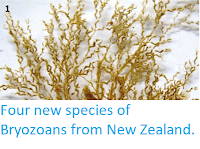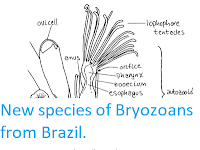Bryozoans, or Moss Animals, are colonial filter-feeding invertebrates that form encrusting or weed-like colonies. The individual 'animals' are on average about 0.5 mm in length, and live inside a protective covering from which they extend a crown of cilia-covered tentacles called a lophophore. These are not true individuals though as they develop as buds on the colony and share nutrients; for this reason they are referred to as 'zooids'. The colonies produce sexually by means of reproductive zooids that have gonads, but lack feeding apparatus. Bryozoans are widespread globally, but are often overlooked because they are small and the colonies resemble plants.
The species Beania magellanica was first recorded in the Magellan Strait, off the coast of Chile, in 1852, and has subsequently been found at widely distributed locations around the coasts of South America, Africa, and Australasia, and as far north as Baja California, southern Japan and the Mediterranean. This is an exceptionally wide distribution for a benthic marine invertebrate, though it is likely to be due to the species ability to grow on the hulls of ships, thereby hitching a ride to new locations far from its starting point. Nevertheless, many similarly widely distributed species have been discovered to be clusters of closely related cryptic species (i.e. species which are closely related, and which cannot be easily separated by physical examination, but which are reproductively isolated).
In a paper published in the journal Marine Biodiversity on 6 November 2018, Javier Souto of the Institut für Paläontologie at Universität Wien, and the Departamento de Zooloxía, Xenética e Antropoloxía Fisica at the Universidade de Santiago de Compostela, Karine Nascimento of the Centro de Biologia Marinha at the Universidade de São Paulo, Oscar Reverter-Gil of the Museo de Historia Natural da Universidade de Santiago de Compostela, and Leandro Vieira of the Laboratório de Estudos de Bryozoa at the Universidade Federal de Pernambuco, describe two new cryptic species of Beania from the north coast of Spain and the Mediterannean.
Cryptic species are species that closely resemble other species, and cannot be separated by simple, non-invasive examination. While taxonomists have known about cryptic species for a long time, it was not realised how numerous such species were until taxonomists began to use genetics to determine relationships between species, about twenty years ago. The presence of cryptic species can have a profound influence on conservation efforts, as ‘species’ thought to be wide ranging with large populations and broad environmental tolerances can turn out to be complexes of closely related but reproductively isolated species, each with a smaller population and distribution, and narrower range of environmental tolerances.
The first new species described is named Beania serrata, in reference to the rostrum of avicularia (specialized defensive zooids) of this species, which is serrated, the only thing which differentiates it physically from Beania magellanica. Souto et al. note that the species was found at two different locations on the northern coast of Spain, an area where specimens of Beania have never previously been recorded, despite having been extremely well surveyed for many years, which leads them to conclude that this species has recently arrived in the area. Since the north coast of Spain is an area of extremely high shipping traffic, it is very hard to say where the species originates from, though it is likely that the home population has previously been identified as Beania magellanica.
In a paper published in the journal Marine Biodiversity on 6 November 2018, Javier Souto of the Institut für Paläontologie at Universität Wien, and the Departamento de Zooloxía, Xenética e Antropoloxía Fisica at the Universidade de Santiago de Compostela, Karine Nascimento of the Centro de Biologia Marinha at the Universidade de São Paulo, Oscar Reverter-Gil of the Museo de Historia Natural da Universidade de Santiago de Compostela, and Leandro Vieira of the Laboratório de Estudos de Bryozoa at the Universidade Federal de Pernambuco, describe two new cryptic species of Beania from the north coast of Spain and the Mediterannean.
Cryptic species are species that closely resemble other species, and cannot be separated by simple, non-invasive examination. While taxonomists have known about cryptic species for a long time, it was not realised how numerous such species were until taxonomists began to use genetics to determine relationships between species, about twenty years ago. The presence of cryptic species can have a profound influence on conservation efforts, as ‘species’ thought to be wide ranging with large populations and broad environmental tolerances can turn out to be complexes of closely related but reproductively isolated species, each with a smaller population and distribution, and narrower range of environmental tolerances.
The first new species described is named Beania serrata, in reference to the rostrum of avicularia (specialized defensive zooids) of this species, which is serrated, the only thing which differentiates it physically from Beania magellanica. Souto et al. note that the species was found at two different locations on the northern coast of Spain, an area where specimens of Beania have never previously been recorded, despite having been extremely well surveyed for many years, which leads them to conclude that this species has recently arrived in the area. Since the north coast of Spain is an area of extremely high shipping traffic, it is very hard to say where the species originates from, though it is likely that the home population has previously been identified as Beania magellanica.
Beania serrata, from Ría de Ferrol, Spain. (a) Septum in a tubular connection between zooids. (b) SEM image showing avicularia and distal spines. (c) Avicularium aspect. Souto et al. (2018).
The second new species described is named Beania mediterranea, in reference to the area where it was found; all specimens examined from throughout the Mediterranean, an area where Beania magellanica had previously been thought endemic and widespread, proved to belong to Beania mediterranea, suggesting that Beania magellanica was never actually present. Beania mediterranea is very similar to Beania magellanica, but lacks oral spines and has larger zooids and avicularia.
Beania mediterranea. (a) Aspect of colony with
tentacle crown expanded. (b)
Optical photos of zooids with
avicularia. (c), (d) Zooids
and avicularia in an SEM image. (e) Septum in a tubular connection between zooids. (f)–(h) Avicularia. Souto et al. (2018).
See also...
Follow Sciency Thoughts on Facebook.







